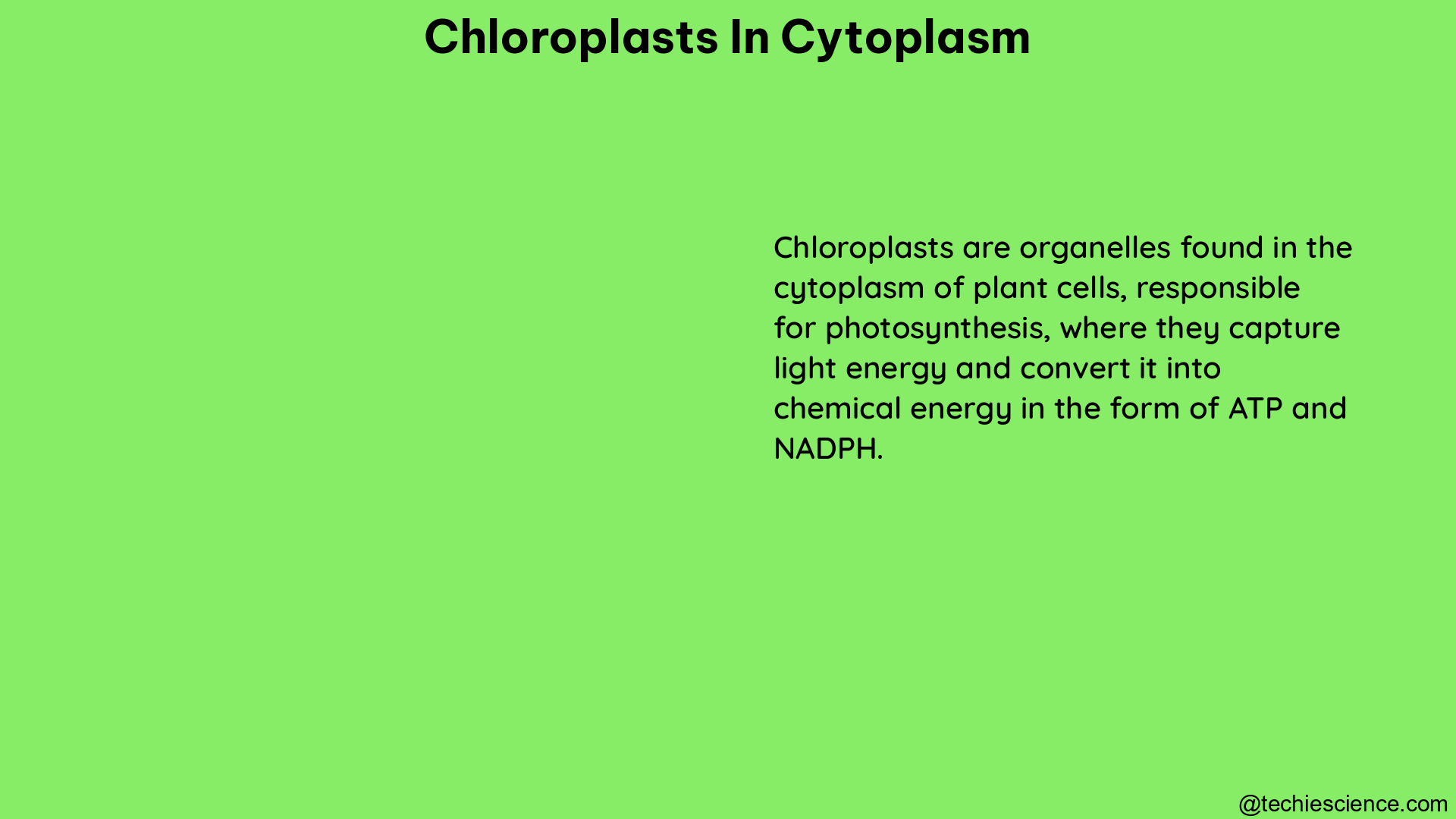Chloroplasts are the powerhouses of plant cells, responsible for the vital process of photosynthesis. These organelles, found within the cytoplasm, are essential for converting light energy into chemical energy, which fuels the growth and development of plants. In this comprehensive guide, we will delve into the intricate details of chloroplasts in the cytoplasm, exploring their structure, function, and dynamic behavior.
Chloroplast Structure and Composition
Chloroplasts are typically discoid or ellipsoidal in shape and are surrounded by a double membrane called the chloroplast envelope. This envelope serves as a protective barrier, allowing the exchange of essential molecules and nutrients between the chloroplast and the cytoplasm.
Inside the chloroplast, there are several distinct structures:
-
Thylakoid Membrane System: This intricate network of flattened, disc-like structures is the site of the light-dependent reactions of photosynthesis. The thylakoid membranes contain chlorophyll and other photosynthetic pigments, which absorb light energy and initiate the conversion of light into chemical energy.
-
Stroma: The stroma is the fluid-filled space surrounding the thylakoid membrane system. It is the site of the light-independent reactions of photosynthesis, where carbon dioxide is converted into organic compounds, such as glucose, through the Calvin cycle.
-
Ribosomes: Chloroplasts contain their own ribosomes, which are responsible for the synthesis of chloroplast-specific proteins, including those involved in photosynthesis.
-
DNA: Chloroplasts possess their own circular DNA, which encodes a small portion of the genetic information required for the organelle’s function and replication.
Quantifying Chloroplasts in the Cytoplasm

Determining the number of chloroplasts per plant cell is an important metric for understanding the photosynthetic capacity of the cell. However, traditional methods of counting chloroplast profiles in two-dimensional (2D) sections of mesophyll cells can lead to significant underestimation of the actual number of chloroplasts.
To overcome this limitation, researchers have developed the unbiased disector method in 3D. This technique involves counting chloroplasts in a series of sections and correcting for section thickness, providing a more accurate estimation of chloroplast number per cell. Using this method, studies have shown that the average number of chloroplasts per mesophyll cell can range from 30 to 100, depending on the plant species and growth conditions.
Chloroplast Dynamics and Light Responsiveness
Chloroplasts in the cytoplasm exhibit dynamic behavior, particularly in response to changes in light conditions. Under dim red light, chloroplasts tend to position themselves in a single layer at the bottom of the cell, with minimal movement. However, upon exposure to bright white light, chloroplasts rapidly leave their local position and move far distances, corresponding to multiple chloroplast diameters.
This light-dependent dynamical phase of chloroplasts is crucial for optimizing photosynthesis and adapting to changing light conditions. By moving within the cytoplasm, chloroplasts can position themselves to maximize light absorption and ensure efficient energy conversion.
The movement of chloroplasts is influenced by various factors, including the cytoskeleton, motor proteins, and signaling pathways that respond to light cues. Researchers have identified several key players in the regulation of chloroplast movement, such as the blue-light photoreceptor phototropin and the actin cytoskeleton.
Chloroplast-Cytoplasm Interactions
Chloroplasts in the cytoplasm do not function in isolation; they interact extensively with the surrounding cytoplasm and other organelles, such as mitochondria and the endoplasmic reticulum.
One important process that facilitates these interactions is cyclosis, the circular movement of cytoplasmic contents. Cyclosis enables the distribution of molecules and vesicles throughout large plant cells, and it also affects the interactions between chloroplasts and the cytoplasm.
Studies have shown that different photosynthetic capacities of chloroplasts under general and localized illumination are related to the lateral transport of chloroplasts, which is influenced by cyclosis. This dynamic interplay between chloroplasts and the cytoplasm is crucial for the efficient distribution of resources and the coordination of cellular processes.
Advanced Techniques for Studying Chloroplasts
To gain a deeper understanding of chloroplasts in the cytoplasm, researchers have employed various advanced techniques and imaging methods. These include:
-
Unbiased Disector Method in 3D: As mentioned earlier, this technique provides a more accurate estimation of chloroplast number per cell by counting chloroplasts in a series of sections and correcting for section thickness.
-
Confocal Microscopy: This advanced imaging technique allows for the visualization of chloroplasts in three dimensions, enabling the study of their spatial distribution and dynamic behavior within the cytoplasm.
-
Fluorescence Imaging: By labeling specific chloroplast components with fluorescent probes, researchers can track the movement and interactions of chloroplasts with other cellular structures in real-time.
-
Electron Microscopy: Transmission electron microscopy (TEM) and scanning electron microscopy (SEM) provide high-resolution images of the internal structure and ultrastructure of chloroplasts, revealing details about their organization and composition.
-
Computational Modeling: Researchers have developed computational models to simulate the behavior of chloroplasts within the cytoplasm, allowing them to study the complex interactions and dynamics involved in photosynthesis and chloroplast movement.
These advanced techniques, combined with traditional methods, have significantly advanced our understanding of chloroplasts in the cytoplasm, enabling researchers to uncover the intricate details of their structure, function, and interactions within the plant cell.
Conclusion
Chloroplasts in the cytoplasm are essential organelles that play a crucial role in the photosynthetic processes of plant cells. By understanding their structure, dynamics, and interactions with the surrounding cytoplasm, researchers can gain valuable insights into the mechanisms that drive plant growth, development, and adaptation to changing environmental conditions.
Through the application of advanced techniques, such as the unbiased disector method in 3D, confocal microscopy, and computational modeling, scientists continue to expand our knowledge of chloroplasts in the cytoplasm, paving the way for new discoveries and advancements in the field of plant biology.
References
- Quizlet. (n.d.). Chapter 10 Summative Quiz. Retrieved from https://quizlet.com/384635070/chapter-10-summative-quiz-flash-cards/
- Wada, M. (2013). Chloroplast movement. Plant Science, 210, 177-182. https://www.ncbi.nlm.nih.gov/pmc/articles/PMC9934296/
- Quizlet. (n.d.). Bio 1 Exam. Retrieved from https://quizlet.com/434020470/bio-1-exam-flash-cards/
- Pyke, K. A., & Howells, C. A. (2002). Plastid and stromule morphogenesis in tomato. Annals of Botany, 90(5), 559-566. https://www.sciencedirect.com/science/article/pii/S0005272811001502
- Hanson, M. R., & Sattarzadeh, A. (2013). Trafficking of proteins through plastid stromules. The Plant Cell, 25(7), 2774-2782. https://www.ncbi.nlm.nih.gov/pmc/articles/PMC3764448/

Hello, I am Piyali Das, pursuing my Post Graduation in Zoology from Calcutta University. I am very passionate on Academic Article writing. My aim is to explain complex things in simple way through my writings for the readers.